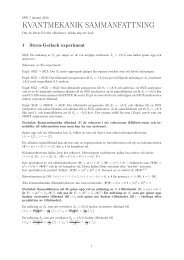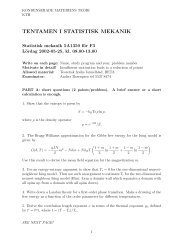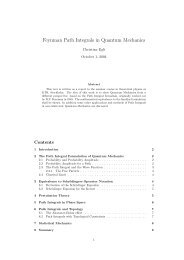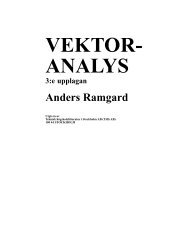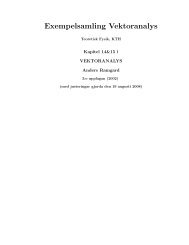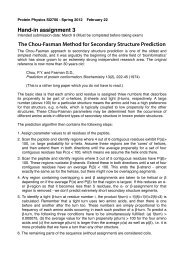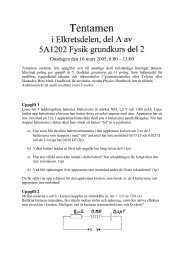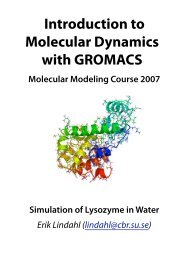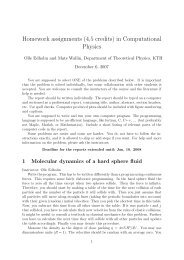[VAR]=Notes on variational calculus
[VAR]=Notes on variational calculus
[VAR]=Notes on variational calculus
Create successful ePaper yourself
Turn your PDF publications into a flip-book with our unique Google optimized e-Paper software.
In these two cases we <strong>on</strong>ly need to solve a 1st order ODE which is a lot simpler.<br />
The proof of this is simple: For (a) we note that F being independent of u(x) means<br />
that ∂F/∂u(x) = 0 and thus (8) becomes<br />
d ∂F<br />
dx ∂u ′ (x) = 0.<br />
equivalent to (13). To prove (b) we differentiate (14) with respect to x:<br />
(<br />
)<br />
d<br />
u ′ ∂F<br />
(x)<br />
dx ∂u ′ (x) − F = 0,<br />
and by a simple computati<strong>on</strong> using the chain rule we see that this is equivalent to<br />
u ′′ ∂F<br />
(x)<br />
∂u ′ (x) + u′ (x) d ∂F<br />
dx ∂u ′ (x) −<br />
∂F<br />
∂u(x) u′ (x) −<br />
∂F<br />
∂u ′ (x) u′′ (x) = 0<br />
where we used ∂F/∂x = 0. The terms proporti<strong>on</strong>al to u ′′ (x) cancel, and pulling out the<br />
comm<strong>on</strong> factor u ′ (x) in the two remaining terms we get the Euler-Lagrange equati<strong>on</strong>s<br />
in (8).<br />
I stress that Fact C is important for solving many examples. To illustrate this I<br />
c<strong>on</strong>sider the following example: Extremize the functi<strong>on</strong>al<br />
S[x] =<br />
∫ t1<br />
( m<br />
)<br />
t 0<br />
2 x′ (t) 2 − V (x(t), t) . (15)<br />
As I discuss below, this is the acti<strong>on</strong> functi<strong>on</strong>al for a particle with mass m > 0 moving<br />
in x-directi<strong>on</strong> and in an external potential V (x, t) depending <strong>on</strong> positi<strong>on</strong> and time t.<br />
The Euler-Lagrange equati<strong>on</strong>s in this example are nothing but Newt<strong>on</strong>’s equati<strong>on</strong>s,<br />
mx ′′ ∂V (x(t), t)<br />
(t) = −<br />
∂x(t)<br />
(16)<br />
(check that!). Moreover, in case V (x, t) = V (x) is independent of t then Fact C (b)<br />
above implies that<br />
m<br />
2 x′ (t) 2 + V (x(t)) = C, (17)<br />
which is nothing but energy c<strong>on</strong>servati<strong>on</strong>. This is useful since the latter ODE can be<br />
solved (in principle) by separati<strong>on</strong>:<br />
∫<br />
dx<br />
√ = t + c<strong>on</strong>st.<br />
2<br />
(C − V (x)) m<br />
This you knew before: the energy of a system is c<strong>on</strong>served <strong>on</strong>ly for potentials which<br />
do not explicitly depend <strong>on</strong> time.<br />
9


![[VAR]=Notes on variational calculus](https://img.yumpu.com/35639168/9/500x640/varnotes-on-variational-calculus.jpg)
